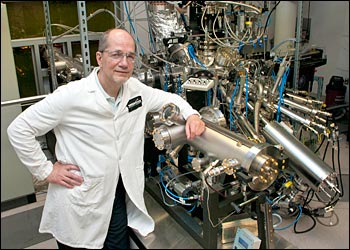Brookhaven Lab’s Ivan Bozovic Wins Bernd T. Matthias Prize for Superconducting Materials
International jury recognizes Bozovic for innovative contributions to the material aspects of superconductivity, an important component for solutions to Nation’s energy challenges
June 18, 2012
By Joe Gettler
Upton, NY — Ivan Bozovic, a physicist in the Condensed Matter Physics and Materials Science Department at the U.S. Department of Energy’s (DOE) Brookhaven National Laboratory, has been honored as a co-recipient of the 2012 Bernd T. Matthias Prize for Superconducting Materials. Recipients of this prize are selected by an international jury to recognize innovative contributions to the material aspects of superconductivity. Superconducting materials are considered to be an important component for solutions to the Nation’s energy challenges, because they can conduct electricity without any electrical resistance or energy wasted. However, most become superconducting only when cooled to very low temperatures near absolute zero (-273 degrees Celsius).
Bozovic will share this prize with James N. Eckstein of the University of Illinois at Urbana-Champaign and Dirk Johrendt of Ludwig-Maximilians-Universitat Munchen in Germany. At the 2012 Materials and Mechanisms of Superconductivity (M2S) Conference to be held July 29 through August 3 in Washington D.C., the laureates will receive a monetary award of $5,000 funded by the Texas Center for Superconductivity at the University of Houston and a framed certificate designed by the Kamerlingh Onnes Laboratory in the Netherlands. The citation honors Bozovic and Eckstein for “Their pioneering and sustained contributions to the novel synthesis and engineering of superconducting materials.”
“More frequently, awards are given for a single important discovery,” Bozovic said. “My research on superconducting materials is characterized by several decades of patience and methodical work to slowly but steadily improve techniques and sample quality. It’s not very glamorous, so I was pleasantly surprised to learn that I received this prestigious honor.”
At Brookhaven, Bozovic is working to understand the properties of known materials that become superconducting at temperatures higher than absolute zero to develop superconducting wires and devices that are more practical for everyday applications. To do this, Bozovic studies superconducting thin films that he engineers and fabricates a single atomic layer at a time using a one-of-a-kind molecular-beam epitaxy (MBE) machine that he built and continues to improve.
“The effects I am studying in high temperature superconductors can be masked by impurities and defects in sample materials,” Bozovic explained. “As we continue to make thin films that are better and better, our experiments yield improved results and we can see intrinsic behavior that hasn’t been seen before.
“The machine I built is extremely productive as well,” Bozovic added. “With almost 100 percent uptime, we have produced more than 1,400 thin-film samples in less than seven years to conduct about 200 experiments each year.”
Bozovic’s research is also important for the Center for Emergent Superconductivity (CES) that the DOE Office of Science established as an Energy Frontier Research Center (EFRC) at Brookhaven Lab, Argonne National Laboratory, and the University of Illinois at Urbana-Champaign in 2009. The CES is one of 46 EFRCs nationwide where scientists are working to make renewable and alternative energy viable as replacements for fossil fuels. Bozovic’s work at the CES contributes toward improving the critical properties of known superconductors and accelerating the search for new superconducting materials to improve the capacity, efficiency, and reliability of the electrical grid, particularly as solar and wind-powered sources are integrated into the system.
Bozovic earned a Ph.D. in physics from the University of Belgrade in Yugoslavia in 1975. He remained there until 1985 and served as a professor and the Head of the Physics Department. From 1986 until 1988, he worked at the Applied Physics Department at Stanford University. He was a senior research scientist at Varian Research Center in Palo Alto, California, 1989 to 1998, and the chief technical officer and principal scientist for Oxxel GmbH in Germany 1998 to 2002. He joined Brookhaven as a senior scientist and the leader of the Molecular Beam Epitaxy group in 2003.
Bozovic’s results have been published in more than 200 research papers and cited more than 5,000 times. Many of these were published in the highest-impact journals such as Nature, Science, and the Physical Review Letters.
DOE’s Office of Science is the single largest supporter of basic research in the physical sciences in the United States, and is working to address some of the most pressing challenges of our time. For more information, please visit science.energy.gov.
2012-11426 | INT/EXT | Newsroom










